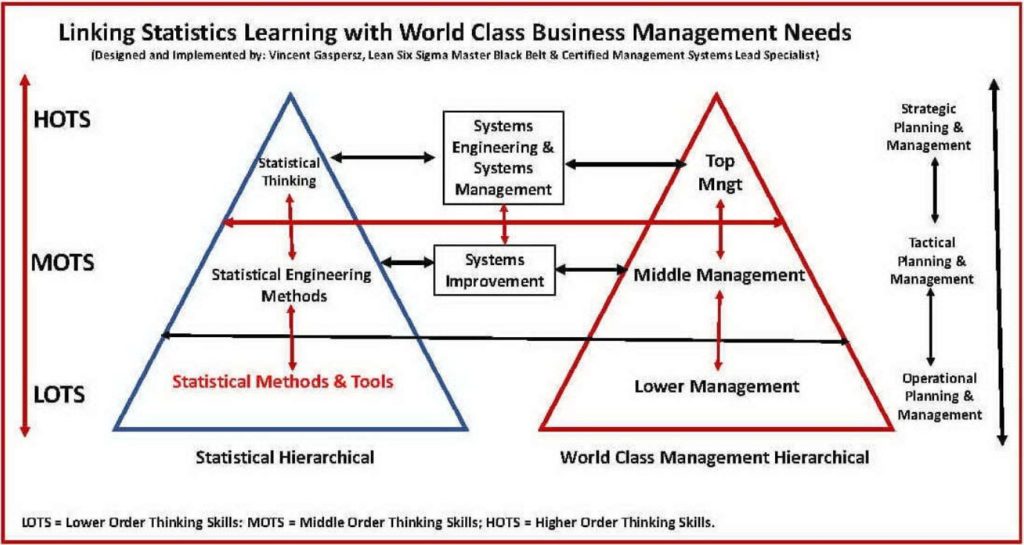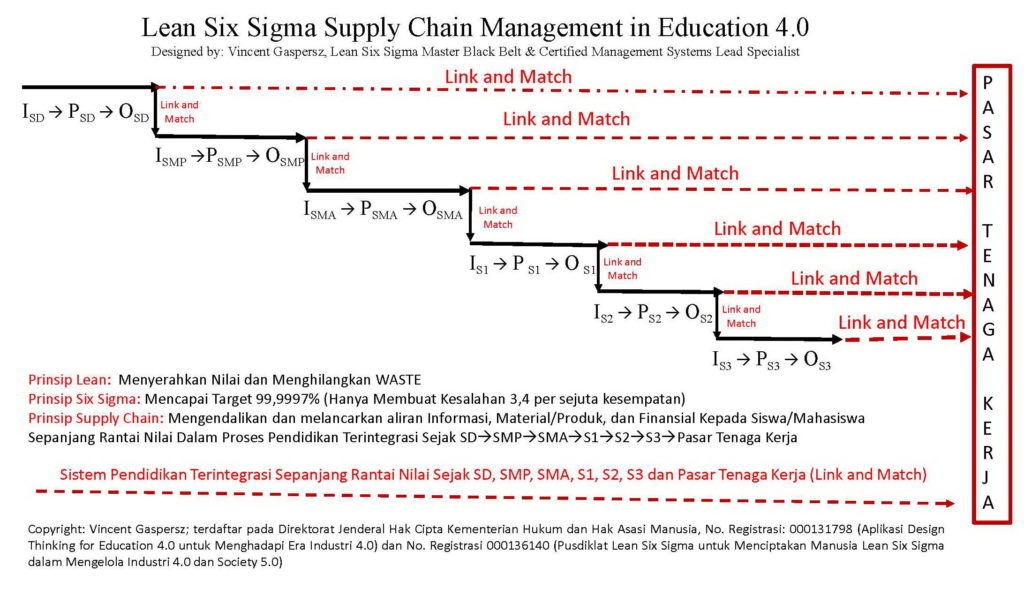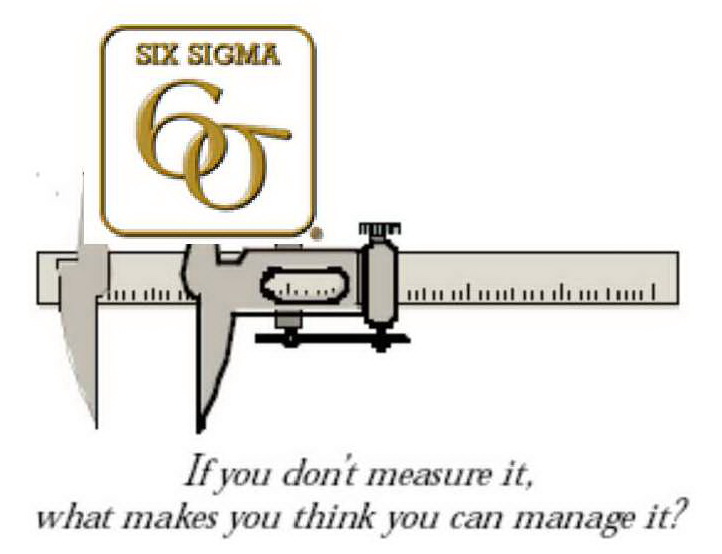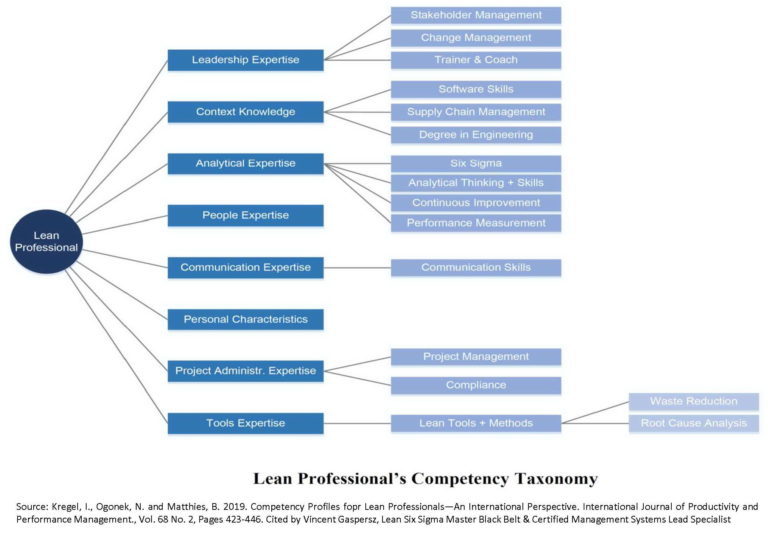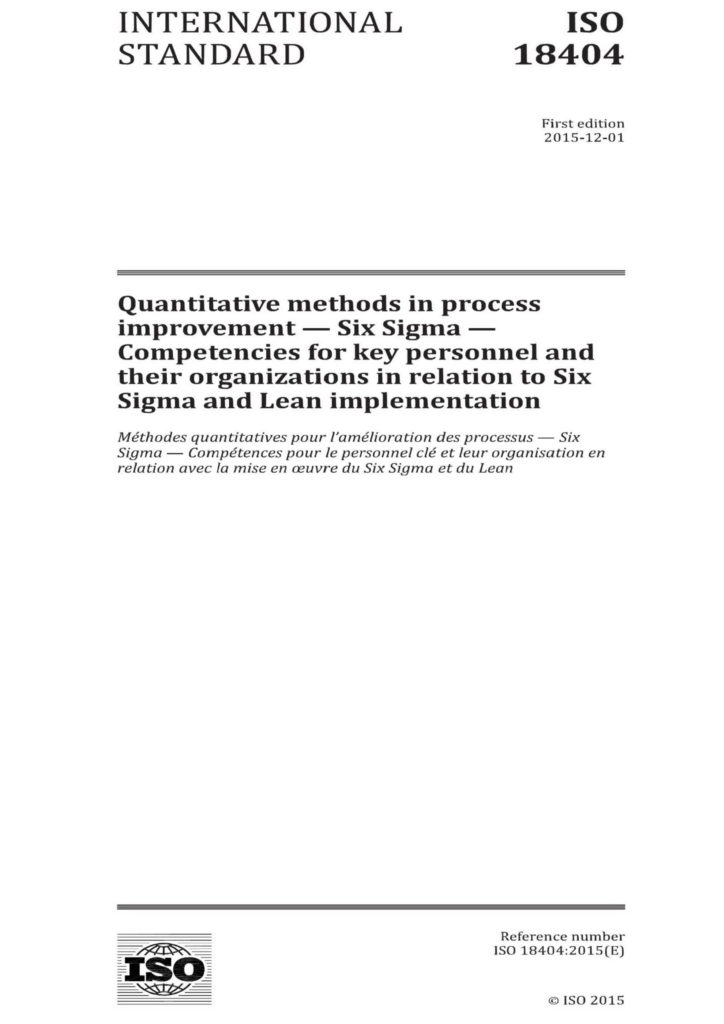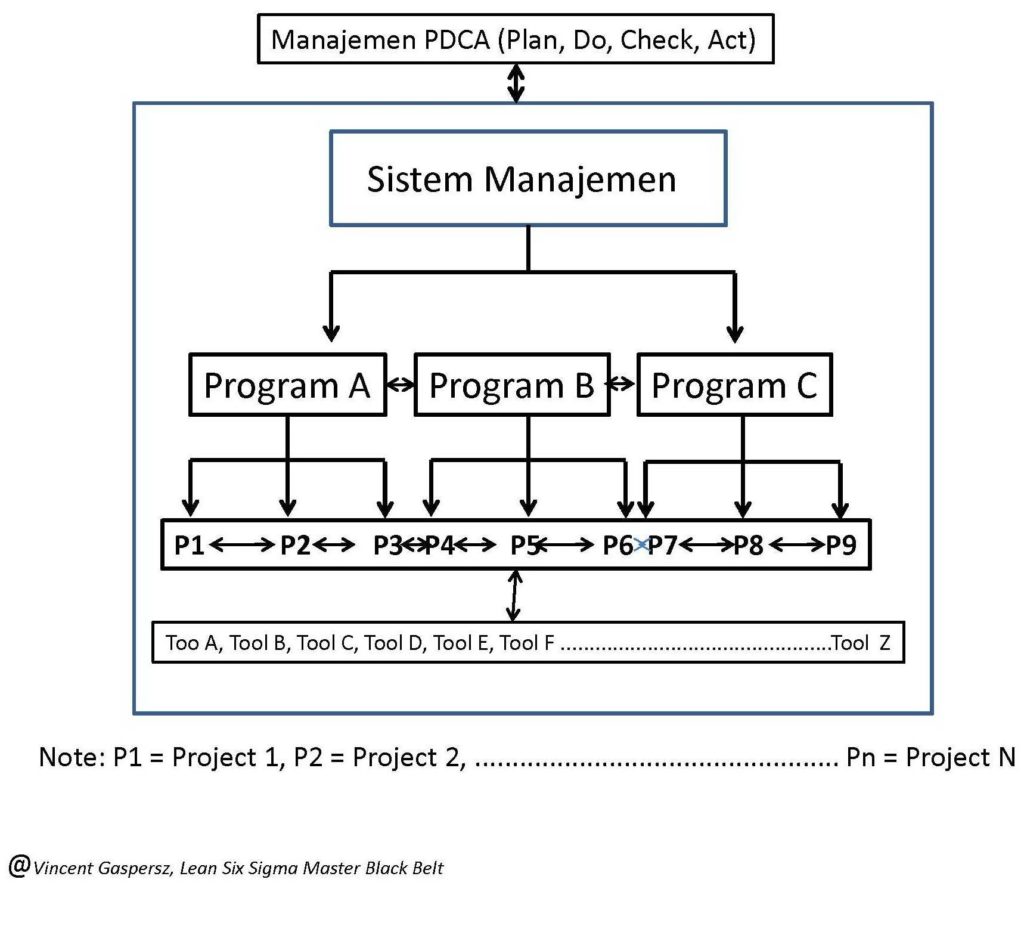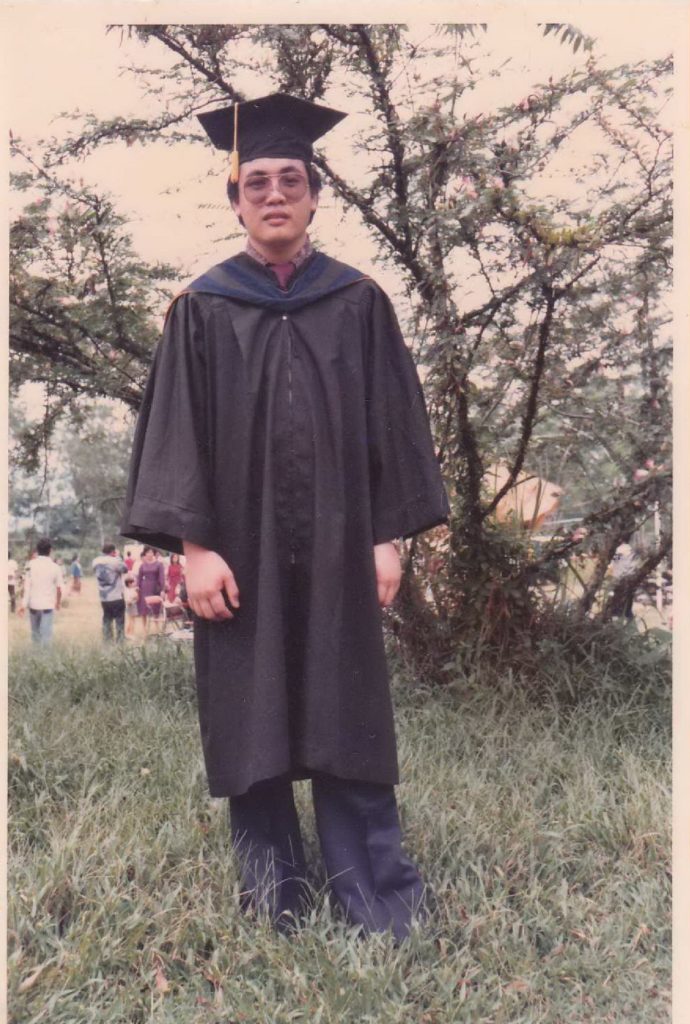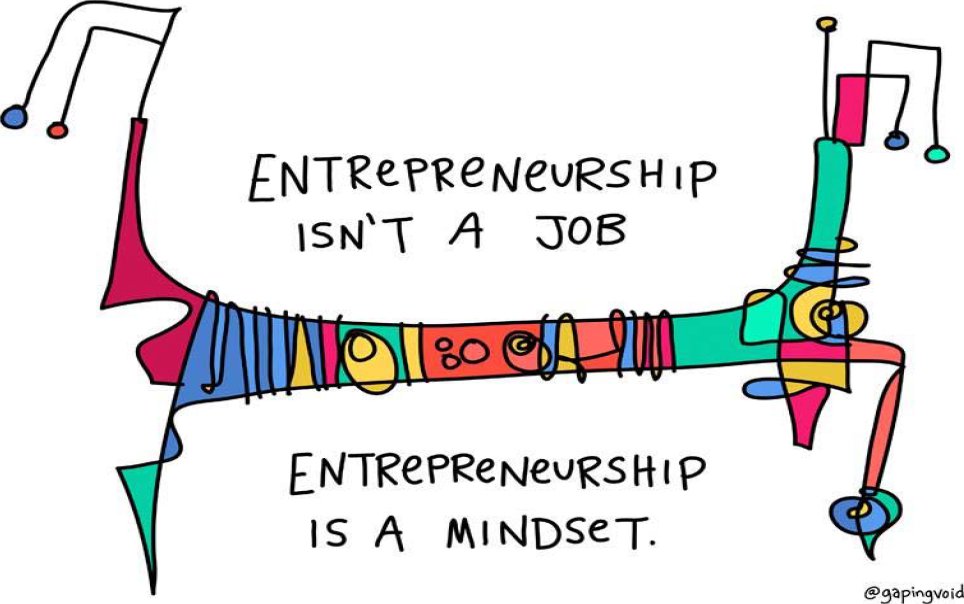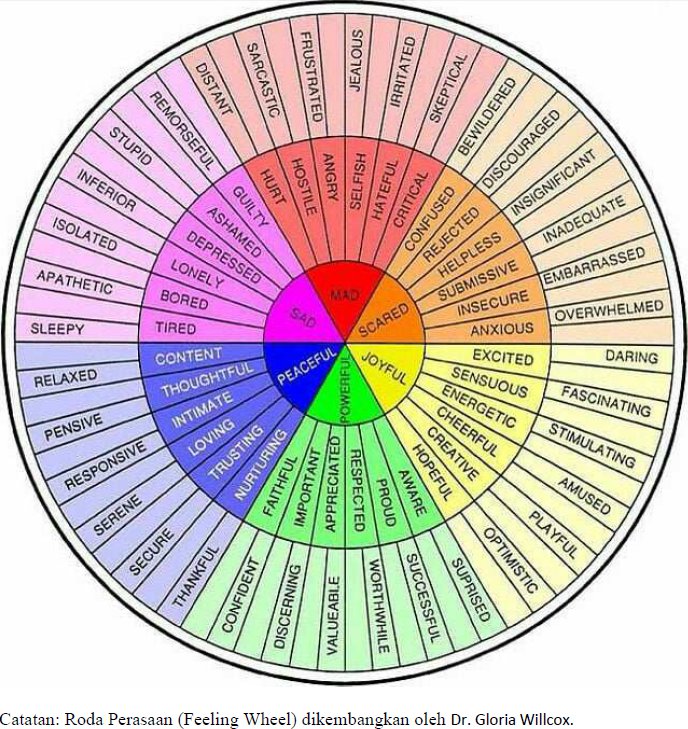-
Bahasa Indonesia
-
English
Oleh: Vincent Gaspersz, Lean Six Sigma Master Black Belt
Pada tulisan-tulisan saya sebelumnya telah diperkenalkan penggunaan PDCA (Plan – Do – Check -Act) berbentuk flowchart (lihat Bagan 1 terlampir), di mana kita HANYA mempunyai 2 jalur, yaitu: (1) Jalur SUCCESS (apabila pada Check: Actual >= Target), dan (2) Jalur GAGAL (apabila pada Check: Actual < Target). Jika kita melewati Jalur SUCCESS, maka akan ada STANDARD (Act to Standardize) dapat berupa penulisan SOPs (Standard Operating Procedures) bagi organisasi atau meningkatkan KARAKTER SUCCESS bagi diri kita secara pribadi. Jika kita menghadapi ke-GAGAL-an (pada Check: Actual < Target), maka SEGERA melakukan Problem Solving menggunakan akronim “GAGAL” melalui memeriksa kembali penyimpangan ketika melakukan Plan (P) dan/atau Do (D) Karena PASTI ada Key SUCCESS Factors (KSFs) yang dilupakan pada saat melakukan Plan (P) dan/ atau tidak memasukkan semua KSFs ke dalam Action Plan (5W-2H) ketika melakukan Do (D), dan/atau kita tidak mengikuti atau menerapkan Action Plan (5W-2H) secara KONSISTEN ketika melakukan DO (D).
Praktek-praktek di atas disebut sebagai Standardisasi mengikuti PDCA Approach secara BENAR dan KONSISTEN, sehingga SUCCESS (pada Check: Actual >= Target) BUKAN terjadi secara kebetulan TETAPI SUCCESS memang TELAH didesain dan diterapkan sejak awal secara benar dan konsisten.
Berkaitan dengan istilah STANDARDISASI ini, maka saya akan memperkenalkan bagaimana mekanisme PDCA (Plan – Do – Check – Act) itu akan diikuti oleh SDCA (Standardize – Do – Check – Act) dan seterusnya kedua pendekatan PDCA dan SDCA ini yang akan dikendalikan oleh kita menuju SUCCESS masa depan.
Bagan Kedua (Terlampir) tentang PDCA – SDCA Cycle TELAH saya modifikasikan dengan menambah Karakter Diri Pemenang berlandaskan pada 7-Habits of Highly Effective People dari Stephen Covey (diperkenalkan pada 1989), True – North Leadership dari Bill George (2007), dan pengalaman PRAKTEK pribadi sehingga pada akhir tulisan ini akan tampak 11 KOMITMEN yang selalu dipraktekkan oleh seorang PEMENANG. Dalam bagan kedua itu saya HANYA menampilkan 3 Habits No. 1, #2, dan #3 dari Stephen Covey (akan saya bahas kemudian) KARENA itu adalah KUNCI menjadi seorang PEMENANG (Private Victory), sedangkan Habits #4, #5, dan #6 adalah untuk memenangkan orang lain/lingkungan/publik (Public Victory), sedangkan Habit #7 adalah belajar terus-menerus untuk perbaikan dalam hal Problem Solving dan/atau Continual Improvement (Gradual/Incremental or Rapid/Breakthrough).
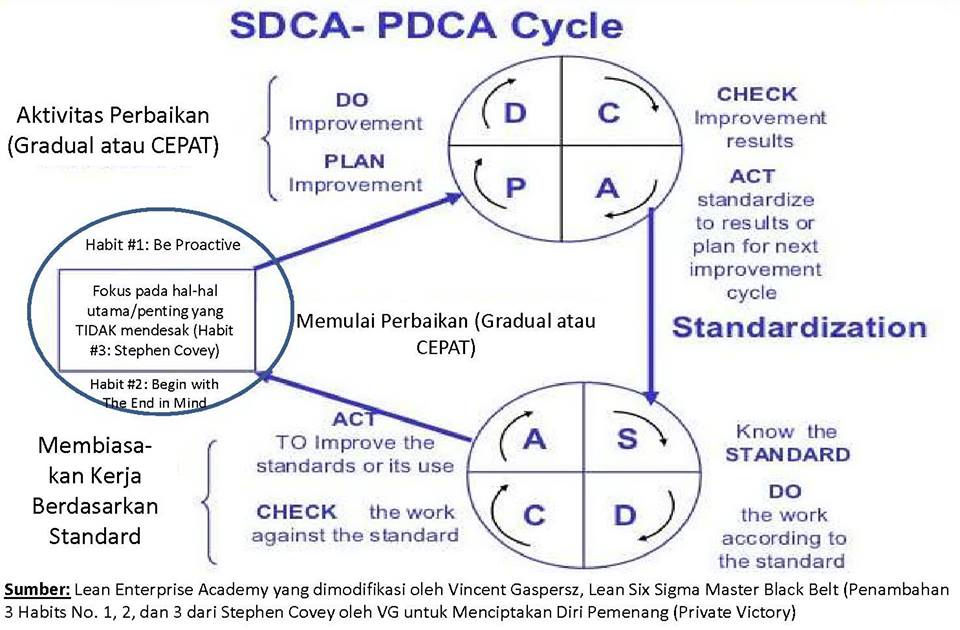
Jika kita TELAH membekali diri kita dengan KARAKTER PEMENANG (100% merupakan tanggung jawab pribadi), kemudian kita mempraktekkan PDCA/SDCA terus-menerus, maka diharapkan akan meningkatkan REPUTASI kita (100% berasal dari penilaian orang lain/lingkungan terhadap diri kita). Dengan demikian landasan SUCCESS akan menjadi KOKOH: yaitu: KARAKTER dan REPUTASI.
Perhatikan Bagan 2 (terlampir): kita akan memulai merencanakan perbaikan melalui implementasi tahap P (Plan) dalam siklus PDCA. Pilihan apakah perbaikan secara GRADUAL/SMALL IMPROVEMENT atau RAPID/BREAKTHROUGH IMPROVEMENT akan tergantung pada situasi dan kondisi kita. Bagi saya pribadi yang SADAR DIRI telah tertinggal daripada mereka yang memperoleh kesempatan belajar dan praktek secara professional di negara-negara maju, PASTI akan terus-menerus tertinggal jika masih memilih GRADUAL/SMALL IMPROVEMENT. Dengan demikian saya SELALU berusaha untuk melakukan RAPID/BREAKTHROUGH IMPROVEMENT kepada diri pribadi, sedangkan kepada TEAM (Together Everyone Achieves More) akan bertoleransi memilih GRADUAL/SMALL IMPROVEMENT atau RAPID/BREAKTHROUGH IMPROVEMENT tergantung pada tingkat kematangan dari TEAM itu. Semakin matang dan ber-KOMPETEN TEAM itu tentu akan dipilih RAPID/BREAKTHROUGH IMPROVEMENT.
Selanjutnya setelah menetapkan SMARTERS Goal, memahami semua Key SUCCESS Factors (KSFs), memasukkan semua KSFs ke dalam Action Plan (5W-2H), dstnya, kita akan menjalankan PDCA Approach seperti telah di bahas dalam tulisan yang lalu.
Ketika kita mencapai SUCCESS pertama, maka seharusnya ada PRAKTEK STANDARD terhadap kebiasaan kita belajar dan/atau beraktivitas itu agar kita terbiasa dengan DISIPLIN beraktivitas menggunakan STANDARD. Orang-orang SUCCESS atau negara-negara maju SELALU menggunakan STANDARDS dalam beraktivitas.
Tentang STANDARDISASI ini MASIH merupakan tantangan utama bagi banyak orang di Indonesia, Karena BELUM menjadi HABITS apalagi menjadi KARAKTER. Kita telah terbiasa dengan berbagai “penyimpangan” terhadap STANDARD sehingga hasilnya dapat dilihat sendiri bahwa kita terus-menerus tertinggal dari orang-orang lain di negara-negara maju.
Sebagai kasus sederhana TETAPI telah dianggap hal yang biasa di Indonesia sehingga TIDAK MAU diperbaiki adalah contoh sederhana berikut.
Saya setiap bulan selalu ke Surabaya menggunakan pesawat Batik Air dari Jakarta. Telah menjadi kebiasaan saya untuk melakukan web-check in. Boarding pass yang dihasilkan dari Web Check In adalah: Gate No. 6C di Terminal 1C Bandara Soekarno-Hatta. Ketika hari H ke terminal 1C saya melihat pada papan/layar televisi tercantum nama pesawat, nomor penerbangan, jadual keberangkatan menunjukkan tujuan Surabaya ada di Gate No. 7C. Untuk memastikan saya menanyakan kepada petugas Batik Air dan disebutkan bahwa Gate No. 7C (Gate No. 7 di Terminal 1C). Lalu saya menunggu di Gate No. 7C. Pada waktu mau berangkat (boarding) petugas Batik Air berteriak-teriak seperti di terminal bus: Surabaya 4C, yang tujuan Surabaya 4C, dst berulang-ulang, baru diumumkan oleh petugas secara resmi melalui pengeras suara bahwa penumpang tujuan Surabaya silakan naik pesawat melalui Gate No. 4C (Gate No. 4). Tampak sederhana TETAPI hal itu berulang-ulang selama lebih dari setahun dan sampai sekarangpun terus-menerus TIDAK ADA STANDARD yang jelas. Padahal pesawat, jadual keberangkatan, tujuan adalah sama sepanjang waktu. TENTU saja hal seperti ini TIDAK akan terjadi di negara maju seperti: Malaysia dan Singapore.
Berikut ini akan dibahas mengapa jika kita tidak terbiasa dengan STANDARD?, maka kita TIDAK akan mampu melakukan perbaikan secara CEPAT dibandingkan orang-orang yang telah SUCCESS.
Konsekuensinya kita akan FRUSTRASI atau PASRAH saja pada “NASIB” dan HANYA selalu mengucapkan kata-kata POTENSI bukan KOMPETENSI. Atau pernyataan: sayang sekali orang itu sesungguhnya ber-POTENSI hanya TIDAK memiliki KESEMPATAN. Ingat: Kesempatan diciptakan berdasarkan KOMPETENSI bukan ditunggu!!
Patut dicatat yang terpenting adalah KOMPETENSI bukan POTENSI, Karena KOMPETENSI mengikuti STANDARD itu yang akan berhasil mengubah POTENSI menjadi ACTUAL agar sesuai dengan SMARTERS Goal kita.
Setiap manusia memiliki POTENSI sebagai PEMENANG, Karena bukankah setiap orang yang lahir ke dunia adalah SUCCESS bagi sepasang suami-isteri di mana HANYA satu sel spermatozoa (dari jutaan sel spermatozoa) dari seorang suami yang berhasil membuahi satu sel telur dari seorang isteri? TETAPI mengapa POTENSI Pemenang itu TIDAK BISA diubah menjadi AKTUALISASI DIRI? Semata-mata Karena TIDAK ADA KOMPETENSI dari KARAKTER seorang PEMENANG!
Stephen Covey secara sangat sederhana HANYA mengungkapkan tiga kebiasaan yang HARUS diterapkan agar memenangkan diri pribadi (Private Victory) yang akan dibahas secara singkat berikut.
Habit No. 1: BE PROACTIVE
Kata PROAKTIF berkaitan dengan bagaimana kita merespons sesuatu yang terjadi dan hal ini berarti kita bersedia mengambil tanggung jawab yang terdiri dua hal utama yaitu: tanggapan (response) dan kemampuan (ability), sehingga orang yang bertanggung jawab adalah orang yang memiliki ATTITUDE, HABIT, dan KARAKTER PROAKTIF.
Catatan: Responsibility = Response + Ability.
Yang menjadi MASALAH adalah banyak orang yang TIDAK SADAR DIRI bahwa mereka TIDAK KOMPETEN, sehingga MAU atau RELA meningkatkan KOMPETENSI mereka agar memiliki ABILITY untuk menanggapi (RESPONSE) terhadap segala sesuatu yang terjadi. Konsekuensi dari ke-TIDAK SADAR-an DIRI bahwa kita TIDAK BERKOMPETEN (merasa diri bisa TETAPI sesungguhnya TIDAK bisa), maka tidak ada upaya untuk belajar terus-menerus agar meningkatkan KOMPETENSI. Karena kita TIDAK mau PROAKTIF, maka kita PASTI akan memiliki kebiasaan dan karakter REAKTIF, yaitu: SELALU menyalahkan orang lain dan lingkungan atas hambatan-hambatan atau masalah yang dihadapi. Akan menjadi BERBAHAYA jika REAKTIF ini telah menjadi KARAKTER dan selalu mengemukakan alasan pembenaran untuk TIDAK MAU menyalahkan diri sendiri. Karakter REAKTIF adalah kebiasaan pertama dari PECUNDANG, sedangkan Karakter PROAKTIF adalah kebiasaan pertama dari PEMENANG!
Di antara STIMULUS dan RESPONSE, kita memiliki POWER untuk BEBAS memilih tanggapan kita, dan hal ini merupakan kunci untuk SUCCESS. Dalam hal ini kita perlu memahami factor 5C untuk SUCCESS adalah: C1 = CHANGE, C2 = CHALLENGE, C3 = CHANCE, C4 = CHOICE, dan ke-4C ini ditopang oleh COMMITMENT seperti ditunjukkan dalam Bagan 3 terlampir. Saya akan membahas secara sekilas tentang factor 5C ini (lihat Bagan No. 3 terlampir):
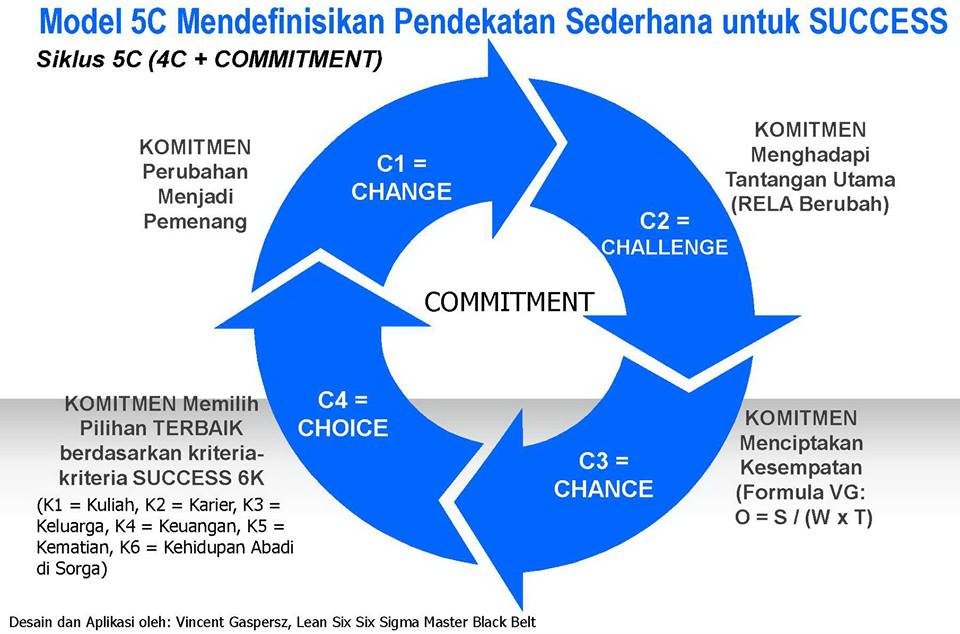
- C1 = CHANGE. Perubahan (Change) di mulai dari dalam diri kita dan orang-orang SUCCESS membuat KEPUTUSAN untuk meningkatkan kehidupan mereka melalui hal-hal utama yang mereka DAPAT mempengaruhi dan BUKAN sekedar bereaksi (REAKTIF) secara sederhana terhadap hambatan-hambatan dari orang lain atau lingkungan luar diri. NILAI terpenting bagi orang ber-KARAKTER SUCCESS adalah meningkatkan KEMAMPUAN (ABILITY) mereka untuk memberikan tanggapan (RESPONSE) yang TEPAT agar mengatasi hambatan-hambatan yang datang dari luar diri mereka (orang lain dan lingkungan), sehingga PROAKTIF hanya terjadi pada mereka yang memiliki TANGGUNG JAWAB (RESPONSE + ABILITY = RESPONSIBILITY). Sedangkan orang-orang REAKTIF sibuk untuk menyalahkan orang lain dan lingkungan atas ke-GAGAL-an mereka.
- C2 = CHALLENGE. Ini merupakan TANTANGAN utama untuk mengubah MINDSET, ATTITUDE, HABITS, dan CHARACTER dari REAKTIF menjadi PROAKTIF. Banyak orang TIDAK MAMPU atau TIDAK RELA berubah, dan mereka TELAH memutuskan untuk menjadi PECUNDANG (sadar atau tidak sadar). Bagi orang-orang yang ingin menjadi PEMENANG, maka tahapan C2 = CHALLENGE ini akan dilewati untuk perubahan menjadi manusia PROAKTIF agar MAMPU mencapai tahapan SUCCESS selanjutnya.
- C3 = CHANCE. Kesempatan (CHANCE) HANYA terbuka bagi orang-orang PROAKTIF sedangkan bagi mereka yang REAKTIF hampir TIDAK ADA kesempatan sama sekali (peluang untuk memperoleh kesempatan sangat KECIL). Saya pribadi menggunakan analisis SWOT (Strengths-Weaknesses bersumber dari dalam diri vs. Opportunities—Threats dari luar diri/orang lain dan lingkungan) untuk menciptakan banyak kesempatan melalui formula VG: O = S / (W x T), artinya jika VG ingin menciptakan banyak kesempatan (O = Opportunities), maka ia HARUS belajar terus-menerus (suka atau tidak suka) untuk menghilangkan/mengurangi kelemahan-kelemahan (Weaknesses) yang bersumber dari dalam diri, sekaligus strategi ini akan meningkatkan kekuatan-kekuatan (S = Strengths) dalam diri dan mengurangi ancaman-ancaman (T = Threats) dari luar diri.
Dengan demikian akan tercipta banyak kesempatan-kesempatan (O = Opportunities), melalui 3 cara sesuai formula O = S / (W x T), yaitu: (1) Menghilangkan/mengurangi kelemahan-kelemahan yang ada dalam diri (W = Weaknesses), (2) Meningkatkan kekuatan-kekuatan (S = Strengths) atau kemampuan (ABILITY) Karena kelemahan TELAH hilang/berkurang, (3) menanggapi atau memberikan tanggapan (RESPONSE) yang TEPAT terhadap ancaman atau hambatan (Threats) yang berasal dari luar diri. Dengan demikian VG akan memiliki RESPONSIBILITY (Response + Ability) untuk menanggapi setiap hambatan yang berasal dari luar diri (orang lain dan lingkungan). Dengan kata lain VG Memiliki kemampuan (ABILITY) untuk memberikan tanggapan (RESPONSE) yang tepat dalam mengatasi berbagai hambatan/ancaman dari luar diri (orang lain dan lingkungan). INGAT: Kesempatan HARUS diciptakan BUKAN hanya ditunggu saja. Pernyataan berikut sangat menarik untuk dibaca: Opportunity is NOWHERE (Kesempatan TIDAK ADA di mana-mana, bagi orang-orang REAKTIF) vs. Opportunity is NOW HERE (Kesempatan ADA di sini sekarang, bagi orang PROAKTIF).
- C4 = CHOICE. Jika kita memiliki banyak kesempatan (C3 = CHANCE atau O = Opportunities) baru kita memiliki pilihan-pilihan, dan kita bisa memilih pilihan TERBAIK dari semua pilihan-pilihan yang baik. Ketika kita TELAH memiliki POWER untuk melakukan berbagai pilihan terbaik dari pilihan-pilihan yang ada, maka kita TELAH berhak SUCCESS mengatur diri sendiri sesuai SMARTERS Goal kita. PECUNDANG PASTI tidak memiliki pilihan-pilihan Karena pilihan yang ada terbatas juga pilihan itu JELEK/BURUK. Akhirnya PECUNDANG hanya mengeluh dan menyalahkan orang lain dan lingkungan atas ke-TIDAK MAMPU-an mereka.
- C5 = COMMITMENT. SUCCESS adalah KOMITMEN untuk maju terus-menerus melakukan C1, C2, C3, dan C4 di atas.
Habit #2: BEGIN WITH THE END IN MIND: PRINSIP DARI VISI PRIBADI
- Visi pribadi VG adalah: UANG (Usaha Agar Nama Gemilang), merupakan SMARTERS Goal dari VG selama hidup di dunia berdasarkan prinsip-prinsip “True-North” yang akan menjadi pedoman hidup sehari-hari. Orang-orang SUCCESS selalu berpikir jangka panjang (5, 10, 25 tahun, dst), kemudian menetapkan SMARTERS Goal yang STRATEGIK menggunakan metode mereka masing-masing. Khusus VG SELALU menggunakan metode PDCA (Plan, Do, Check, Act) yang TELAH terbukti SUCCESS. Untuk STANDARDISASI, maka dipergunakan: SDCA (Standardize, Do, Check, Act).
Habit No. 3. First Things First: Prinsip INTEGRITAS dan EKSEKUSI.
- Jika kita telah terbiasa menggunakan Habit No. 1 (Proaktif) dan Habit No. 2 (Berpikir Strategik Jangka Panjang), baru kita akan memiliki kerangka kerja (framework) untuk mem-PRIORITAS-kan aktivitas-aktivitas kita, mana yang: (1) PENTING dan TIDAK MENDESAK (FOCUS disini), (2) PENTING dan MENDESAK (CEPAT selesaikan agar TIDAK memberikan dampak negatif), (3) Mengabaikan hal-hal yang TIDAK PENTING.
Ringkasan PEMENANG Versi Vincent Gaspersz:
Dari uraian di atas, maka kita bisa mencirikan KARAKTER seorang PEMENANG (winner) sejak awal, yaitu:
- Memiliki KOMITMEN untuk menjadi seorang PEMENANG yang SUCCESS, melalui aplikasi item-item berikut.
- KOMITMEN untuk berubah dari REAKTIF menjadi PROAKTIF melalui belajar meningkatkan kemampuan (ABILITY) agar mampu mengatasi tantangan yang berasal dari luar diri (orang lain dan lingkungan) melalui memberikan tanggapan (RESPONSE) yang TEPAT. Pemenang memiliki tanggung jawab (RESPONSIBILITY = RESPONSE + ABILITY) untuk SUCCESS, Jika menghadapi MASALAH, maka seorang pemenang akan bertanya: Mengapa Aku Salah?, Lalu berusaha memperbaiki kesalahan-kesalahan yang telah dilakukan. Masalah dapat terjadi Karena RESPONSE yang TIDAK TEPAT, Misalnya: Masalah yang bersumber dari dalam diri (controllable factors) Karena menyimpang dari Standar Key SUCCESS Factors (KSFs). Masalah yang bersumber dari luar diri (uncontrollable BUT predictable factors) Karena TIDAK melakukan ANTISIPASI terlebih dahulu akan faktor-faktor penyebab ini. Masalah yang bersumber dari luar diri yang tidak diketahui sebelumnya (uncontrollable AND unpredictable factors) Karena TIDAK ber-DOA (Depend On Allah) memohon keterlibatan Tuhan sejak awal untuk mengatur hidup kita mencapai SUCCESS,
- KOMITMEN untuk disiplin memulai berpikir STRATEGIK jangka panjang (3, 5, 10, 25 tahun, dst), kemudian dari Strategic Goals itu di turunkan menjadi Tactical Goals (jangka waktu 1 tahun) dan dikerjakan setiap hari/mingguan/bulanan pada Operational Goals and Activities. Dengan demikian pencapaian Operational Goals akan mendukung Tactical Goals yang secara otomatis akan mendukung pula Strategic Goals di masa yang akan datang.
- KOMITMEN untuk HANYA berfokus pada hal-hal utama yang PENTING dan TIDAK MENDESAK. Sekitar 90% dari waktu PEMENANG akan dilakukan pada aktivitas-aktivitas PARETO (20% Aktivitas Utama yang berkontribusi pada 80% pencapaian STRATEGIC GOALS), sedangkan sisanya 10% untuk mengatasi hal-hal utama yang TELAH mendesak (Hal-hal PENTING dan MENDESAK). Mereka MAMPU memilah hal-hal TIDAK PENTING dan TELAH mengabaikan atau menyingkirkan sejak awal atau mendelegasikan kepada orang lain untuk mengurusnya.
- KOMITMEN untuk bekerja sama yang menguntungkan orang lain/lingkungan (Win – Win, seringkali untuk keperluan STRATEGIK pemenang RELA rugi terlebih dahulu untuk meraih kesempatan yang lebih besar).
- KOMITMEN untuk SELALU memenuhi kebutuhan orang lain/lingkungan melalui memahami kebutuhan orang lain/lingkungan terlebih dahulu baru meminta orang lain/lingkungan memahami mereka kemudian. Ini adalah prinsip Total Quality Person (TQP), yaitu berusaha untuk memuaskan orang lain sebagai CUSTOMER.
- KOMITMEN untuk bekerja sama dalam TEAM (Together Everyone Achieves More) agar terjadi sinergi (1 + 1 lebih besar dari 2, mungkin 10, 20, dst).
- KOMITMEN untuk berubah dan melakukan perbaikan terus-menerus dalam hal keterampilan Problem Solving, Continual Improvement (Gradual Improvement: Kaizen/Small Group Activities—SGAs maupun Rapid Improvement: Kaizen Blitz/Kaizen Event/Benchmarking/Lean Six Sigma, dll).
- KOMITMEN untuk BERANI menghadapi tantangan (BERANI GAGAL) dengan membekali terus-menerus kemampuan (ABILITY) agar dapat mengatasi tantangan itu secara TEPAT melalui memberikan tanggapan (RESPONSE) yang benar. Ingat: RESPONSIBILITY = RESPONSE + ABILITY. Tidak ada istilah Menyerah atau PUTUS ASA bagi seorang pemenang untuk maju mencapai SUCCESS.
- KOMITMEN untuk SELALU menciptakan kesempatan-kesempatan, melalui: (1) menghilangkan/mengurangi kelemahan-kelemahan dalam diri, (2) meningkatkan kemampuan (ABILITY) dalam diri, (3) memberikan RESPONSE yang TEPAT terhadap semua tantangan/ancaman dari luar diri melalui ke-MAMPU-an (ABILITY) yang TELAH meningkat terus-menerus itu. Ingat: Formula VG: O = S / (W x T), di mana: O = Opportunities, S = Strengths, W = Weaknesses, T = Threats.
- KOMITMEN untuk SELALU menikmati HASIL melalui memilih pilihan-pilihan terbaik dari berbagai pilihan baik yang ada. Kriteria pemilihan pilihan-pilihan terbaik itu berdasarkan kriteria SUCCESS 6K: (1) K1 = Kuliah, (2) K2 = Karier sebagai Profesional, (3) K3 = Keluarga, (4) K4 = Keuangan, (5) K5 = Kematian TANPA PENYESALAN seperti tidak meninggalkan hutang/beban kepada isteri/anak/cucu, dll, dan (6) K6 = Kehidupan Abadi di Sorga Karena telah ber-IMAN (Ikhlas Menjadikan Allah Nakhoda), selalu menerapkan KASIH (Kehendak Allah Selalu Isi Hati), dan terus-menerus memperbesar HATI (Harmonisasi Antara Tindakan dan IMAN). KOMITMEN No. 11 ini sangat PENTING agar meningkatkan POSITIVE REINFORCEMENT (Penguatan Positif) terhadap KARAKTER SUCCESS kita, sehingga kita TIDAK PERLU mengharapkan pengakuan dan penghargaan (Reward & Recognition) dari orang lain/lingkungan. Jika orang lain/lingkungan memberikan Reward & Recognition, maka kita menerima dengan rasa bersyukur, TETAPI kinerja (performance) kita TIDAK ditentukan oleh Reward & Recognition dari orang lain/lingkungan. Menghargai dan mengakui DIRI sendiri untuk terus-menerus berprestasi menjadi pemenang (SUCCESS) jauh lebih penting daripada hal-hal lain termasuk reward & recognition dari luar diri (orang lain dan lingkungan).
Jika 11K (KOMITMEN) di atas TELAH ada dalam diri seorang PEMENANG, maka kita yang telah bertekad untuk SUCCESS akan mengendalikan PDCA-SDCA (Plan-Do-Check-Act/Standardize-Do–Check–Act) dalam setiap langkah kehidupan kita menuju SUCCESS 6K tersebut di atas.
Tulisan mendatang akan membahas tentang penggunaan PDCA/SDCA agar SUCCESS dalam Karier (SUCCESS K2 = Karier) dan SUCCESS mencapai kebebasan finansial (SUCCESS K4 = Keuangan).
Salam SUCCESS.
KEY TO SUCCESS: Creating A Winner-Self to Always Control PDCA Approach
By: Vincent Gaspersz, Lean Six Sigma Master Black Belt
In my previous writings, I have introduced the use of flowchart-shaped PDCA (Plan – Do – Check – Act) (see Figure attached above), where we ONLY have 2 lanes, namely: (1) SUCCESS Lane (if at Check: Actual >= Target), and (2) FAILURE LANE (if at Check: Actual < Target). If we pass SUCCESS Lane, then there will be STANDARD (Act to Standardize); it may be the writing of SOPs (Standard Operating Procedures) for the organization or to increase CHARACTER of SUCCESS for ourselves personally. If we face FAILURE (at Check: Actual < Target), then IMMEDIATELY do Problem Solving using the “GAGAL” // "FAIL" acronym through re-examining the deviations when doing Plan (P) and/or Do (D) because SURELY there have been forgotten Key SUCCESS Factors (KSFs) when conducting Plan (P) and/or we do not include all KSFs into the Action Plan (5W-2H) when conducting do (D), and/or we do not follow or implement the Action Plan (5W-2H) CONSISTENTLY basis when conducting DO (D).
The above practices are referred to as the Standardization following PDCA Approach CORRECTLY and CONSISTENTLY, so that SUCCESS (on Check: Actual >= Target) occurs NOT by chance is, BUT SUCCESS has been designed and implemented from the beginning correctly and consistently.
In connection with this term of STANDARDIZATION, then I will introduce how that PDCA (Plan – Do – Check – Act) mechanism would be followed by SDCA (Standardize – Do – Check – Act) and so on; both of these PDCA and SDCA approaches have to be controlled by us toward future SUCCESS.
The Second (Attached) Chart below on PDCA – SDCA Cycle that HAS been modified by adding Winner-Self Character based on 7-Habits of Highly Effective People by Stephen Covey (introduced in 1989), True – North Leadership by Bill George (2007), and personal PRACTICAL experience so that at the end of this article, there will be 11 COMMITMENTS to be always practiced by a WINNER. In that second chart, I ONLY show 3 Habits: #1, #2, and #3 from Stephen Covey (I will discuss later) BECAUSE they are the KEY to be a WINNER (Private Victory), while Habits #4, #5, and #6 are to win others/environment/public (Public Victory), and Habit #7 is a constant learning for improvement in terms of Problem Solving and/or Continual Improvement (Gradual/Incremental or Rapid/Breakthrough).

If we HAVE equipped ourselves with the CHARACTER OF WINNER (100% is one’s personal responsibility), then we practice PDCA/SDCA constantly, these would be hoped to improve our REPUTATION (100% derived from the judgment of others/environment against ourselves). Thus, the foundation to SUCCESS will be STRONG: namely: CHARACTER and REPUTATION.
Note the attached Chart 2: we will begin planning improvements through the implementation of P (Plan) phase in the PDCA cycle. The choice of whether GRADUAL/SMALL IMPROVEMENT or RAPID/BREAKTHROUGH IMPROVEMENT will depend on our own circumstances. For me personally, who am SELF-CONCSCIOUS that have lagged behind than those who have had the opportunity to learn and practice professionally in developed countries, WOULD be constantly left behind if I still choose GRADUAL/SMALL IMPROVEMENT. Thus, I ALWAYS try to do RAPID/BREAKTHROUGH IMPROVEMENT toward myself, whereas toward the TEAM (Together Everyone Achieves More), they will tolerantly pick either GRADUAL/SMALL IMPROVEMENT or RAPID/BREAKTHROUGH IMPROVEMENT depending on the level of maturity of that TEAM. The more mature and COMPETENT that TEAM are, RAPID/BREAKTHROUGH IMPROVEMENT would surely be picked.
Furthermore, after setting SMARTERS Goal, understanding all Key SUCCESS Factors (KSFs), incorporating all KSFs into the Action Plan (5W-2H), and so on, we would run the PDCA Approach as what have been discussed in the last article.
When we have reached the first SUCCESS, then there should be a STANDARD of PRACTICE against our habits of studying and/or doing that activity so that we are accustomed to be DISCIPLINE in doing activity using STANDARD. SUCCESSFUL people or developed countries ALWAYS use STANDARDS in doing activity.
About this STANDARDIZATION, it is STILL a major challenge for many people in Indonesia because it has not YET become HABITS, or moreover CHARACTER. We have been accustomed to a variety of “deviations” against STANDARD so the results can be seen for themselves that we are constantly lagging behind the others from the developed countries.
As a simple case, BUT has been considered so common in Indonesia so it WILL NOT be repaired is the following simple example.
I, every month, always went to Surabaya using Batik Air flight from Jakarta. It had become my habit to do a web check-in. The Boarding pass that was generated from Web Check-In is: Gate No. 6C at Terminal 1C Soekarno-Hatta Airport. When it was the day for me to go to the terminal 1C, I looked at the flight information board/screen that listed the flight name, flight number, and departure schedule, which showed Surabaya, was in the Gate No. 7C. To make sure I asked the Batik Air clerk and mentioned that Gate No. 7C (Gate No. 7 in Terminal 1C). Then I waited at Gate No. 7C. At the time the flight was about to leave (board), the Batik Air employees screamed like in a bus station: “Surabaya 4C, the Surabaya 4C destination, and so on repeatedly, until finally was formally announced by the clerk through loudspeakers that passengers to Surabaya to please take the flight via Gate No. 4C (Gate No. 4). Looks simple, BUT it happened over and over again for over a year; and even today, there is constantly NO clear STANDARD. Whereas the flight, the departure schedule, and the destination should be the same all the time. OF COURSE, such thing like this would NOT happen in developed countries, such as: Malaysia and Singapore.
The following will discuss why if we are not accustomed to STANDARD, then we will NOT be able to do the improvements MORE QUICKER than those people who have been SUCCESSFUL.
Consequently we will be FRUSTRATED or RESIGNED everything to “FATE” and will always pronounce words POTENTIAL not COMPETENCE. Or such a statement: what a pity that that person actually has POTENTIAL, but simply does NOT have a CHANCE. Remember: opportunities are created based on COMPETENCE not based on waiting!!
It is noteworthy that the most important thing is COMPETENCE, not POTENTIAL, because COMPETENCE that follows STANDARD is what will successfully transform POTENTIAL into ACTUAL correspondingly to out SMARTER Goal.
Every human being has a POTENTIAL to be a WINNER, Because is it not that every person who is born into the world is a SUCCESS for a husband and wife where the ONLY one sperm cells (out of millions of sperm cells) from a husband that manages to fertilize an egg cell from a wife? BUT why does that Winner’s POTENTIAL CANNOT be changed into SELF-ACTUALIZATION? Solely that is because there is NO COMPETENCE from the CHARACTER of a WINNER!
Stephen Covey very simply ONLY reveals three habits that MUST be applied in order to win the personal-self (Private Victory) which will be discussed briefly below.
Habit No. 1: BE PROACTIVE
The word PROACTIVE is related to how we respond to something that happens, and this means that we are willing to take the responsibility that consists of two main things: the response and ability, so that the responsible person is a person who has ATTITUDE, HABIT, and PROACTIVE CHARACTER.
Note: Responsibility = Response + Ability.
What becomes the PROBLEM is that many people are NOT SELF-CONSCIOUS that they are NOT COMPETENT, so that they WANT or are WILLING to increase their COMPETENCE in order to have the ABILITY to respond (RESPONSE) towards everything that happens. The consequence of SELF-UNCONSCIOUSNESS is that we are not COMPETENT (feel that we can, BUT we actually CANNOT), so that there is no effort to learn continuously in order to improve COMPETENCE. Because we do NOT want to be PROACTIVE, then we will DEFINITELY have the habit and character of being REACTIVE, namely: ALWAYS blame others and the environment for the obstacles or problems encountered. It will become DANGEROUS if this being REACTIVE has become a CHARACTER and it will always put forward any justification for NOT WILLING to blame oneself. REACTIVE character is the first habit of a LOSER, while PROACTIVE character is the first habit of a WINNER!
Among STIMULUS and RESPONSE, we have the POWER to FREELY choose our response, and this is the key to SUCCESS. In this case we need to understand the 5Cs factor for SUCCESS, which are: C1 = CHANGE, CHALLENGE = C2, C3 = CHANCE, C4 = CHOICE, and all 4C is supported by COMMITMENT as shown in the attached Chart below. I will discuss briefly about 5C factor (see attached Chart below):

- C1 = CHANGE. Change starts from within ourselves and SUCCESSFUL people make DECISION to improve their lives through the main things that they CAN influence and DO NOT merely react (Reactive) simply to constraints from other people or the environment outside the themselves. The most important VALUE for people with CHARACTER OF SUCCESS is to increase their ABILITY to provide the CORRECT RESPONSE in order to overcome the obstacles that come from outside of themselves (others and the environment), so that being PROACTIVE only occurs in those who have RESPONSIBILITY (RESPONSE + ABILITY = RESPONSIBILITY). While REACTIVE people are busy to blame others and the environment for all their FAILURES.
- C2 = CHALLENGE. It is a major CHALLENGE to change MINDSET, ATTITUDE, HABITS, and CHARACTER from being REACTIVE into being PROACTIVE. Many people are UNABLE or UNWILLING to change, and they HAVE decided to become LOSERS (consciously or unconsciously). For people who want to be WINNERS, then this C2 = CHALLENGE stage will be gone through for tramsforming them into PROACTIVE people in order to be ABLE to reach the next stage of SUCCESS.
- C3 = CHANCE. Opportunity (CHANCE) ONLY opens to PROACTIVE people while for those who are REACTIVE, there is almost NO chance at all (the opportunity to get a chance is very SMALL). I personally use SWOT analysis (the Strengths-Weaknesses from within vs. the Opportunities-Threats from outside / others and the environment) to create many opportunities through VG’s formula: O = S / (W x T), meaning that if VG wants to create many opportunities (O = opportunities), then I MUST learn continuously (like it or not) to eliminate/reduce Weaknesses, which comes from within, plus at the same time this strategy will enhance the strengths (S = strengths) within and reduce the threats (T = threats) from the outside.
Thus, there will be a lot of opportunities created (O = Opportunities), in three ways according to the formula O = S / (W x T), namely: (1) Eliminate/reduce weaknesses that exist within (W = Weaknesses), (2) Increase the strengths (S = strengths) or ABILITY because the weaknesses should HAVE been gone/reduced, (3) respond or give a CORRECT RESPONSE towards the threat or obstacle that comes from outside oneself. Thus, VG will have the RESPONSIBILITY (Response + Ability) to respond to any obstacle that comes from outside oneself (other people and the environment). In other words, VG has the ABILITY to give the CORRECT RESPONSE in overcoming various obstacles/threats from outside oneself (other people and the environment). REMEMBER: Opportunity SHOULD be created, NOT just be waited. The following statement is very interesting to read: Opportunity is NOWHERE (NO opportunity everywhere, for REACTIVE people) vs. Opportunity is NOW HERE (There is opportunity right here right now, for PROACTIVE people).
- C4 = CHOICE. If we have many opportunities (C3 = CHANCE or O = Opportunities) then we have choices, and we can choose the BEST one out of all good choices. When we ALREADY HAVE had the POWER to make various good choices out of the existing choices, then we HAVE been entitled to SUCCESSFULLY regulate ourselves according to our SMARTERS Goal. LOSERS DEFINITELY do not have choices Because there are limited choices and those choices are also UGLY/BAD. In the end, LOSERS will just complain and blame other people and the environment for their INCOMPETENCE.
- C5 = COMMITMENT. SUCCESS is COMMITMENT to continually move forward performing C1, C2, C3, and C4 above.
Habit #2: BEGIN WITH THE END IN MIND: PRINCIPLE FROM PERSONAL VISION
- VG’s personal vision is: UANG (Usaha Agar Nama Gemilang) // MONEY (Effort to Make Own Name Brilliantly Known), is SMARTERS Goal of VG while living in the world, based on the principles of “True North” that will govern the daily life. SUCCESSFUL People always think long-term (5, 10, 25, etc.), then assign STRATEGIC SMARTERS Goal using their own methods. VG ALWAYS especially use PDCA (Plan, Do, Check, Act) method which HAS been proven to be SUCCESSFUL. For STANDARDIZATION, then use: SDCA (Standardize, Do, Check, Act).
Habit No. 3. First Things First: INTEGRITY Principle and EXECUTION.
- If we have been accustomed to using Habit No. 1 (Proactive) and Habit No. 2 (Thinking Long-Term Strategically), then we will have a framework to PRIORITIZE our activities, which are: (1) IMPORTANT and NOT URGENT (FOCUS here), (2) IMPORTANT and URGENT (QUICKLY resolve them so that they DO NOT create negative impacts), (3) Ignoring things that are NOT IMPORTANT.
Vincent Gaspersz’ Version of Summary of WINNER:
From the above descriptions, then we can characterize CHARACTERS OF A WINNER from the beginning, namely having:
- COMMITMENT to be a SUCCESSFUL WINNER, through the application of the following items.
- COMMITMENT to change from being REACTIVE into being PROACTIVE through improving the ABILITY to be able to overcome the challenges that come from outside oneself (other people and the environment) through leaving the CORRECT RESPONSE. Winner has the responsibility (RESPONSIBILITY = RESPONSE + ABILITY) for SUCCESS, if faced a PROBLEM, then a winner will ask: Why Am I Wrong?, then try to fix the mistakes that have been made. Problems can occur because of INCORRECT RESPONSE, for example: a problem that originates from within (controllable factors) because of deviating from standard Key SUCCESS Factors (KSFs); a problem that comes from outside oneself (uncontrollable BUT predictable factors) due to NOT doing ANTICIPATION first for these causing factors; a problem originating from outside oneself that is not previously known (uncontrollable AND unpredictable factors) because of NOT ber-DOA (Depend On Allah) // PRAYING (Depend On God) to ask for God’s involvement from the start to organize our lives to reach SUCCESS,
- COMMITMENT to be discipline to start thinking long-term STRATEGICALLY (3, 5, 10, 25 years, etc.), then from that Strategic Goal is scaled into Tactical Goal (within 1 year) and is worked daily/weekly/monthly in Operational Goals and Activities. Thereby, achievement of Operating Goal will support the Tactical Goal that will also automatically support the Strategic Goal in the future.
- COMMITMENT to ONLY focus on the main IMPORTANT and NOT URGENT things. Approximately 90% of WINNER’S time will be spent on the PARETO activities (20% of Main activities that contribute to the 80% achievement of STRATEGIC GOALS), while the remaining 10% will be to overcome the main things that HAVE been urgent (IMPORTANT and URGENT things). The winners are ABLE to sort things that are NOT IMPORTANT and HAVE ignored or dismissed since the beginning or delegated them to other people to take care of them.
- COMMITMENT to cooperate that benefits others/environment (Win – Win, often for the STRATEGIC purpose of the winner, WILLING to take loss in advance in order to achieve a greater opportunity).
- COMMITMENT to ALWAYS meet the needs of other people/the environment through understanding the needs of others/environment first and ask others/environment to understand them later. This is the principle of Total Quality Person (TQP), which is trying to satisfy others as CUSTOMERS.
- COMMITMENT to work together in a TEAM (Together Everyone Achieves More) so that synergy happens (1 + 1 is greater than 2, perhaps 10, 20, etc.).
- COMMITMENT to change and do continuous improvement in terms of Problem Solving, Continual Improvement (Gradual Improvement: Kaizen/Small Group Activities-SGAs and Rapid Improvement: Kaizen Blitz/Kaizen Event/Benchmarking /Lean Six Sigma, etc.).
- COMMITMENT to DARE to face challenges (DARE TO FAIL) by providing continual ABILITY in order to overcome those challenges CORRECTLY by giving appropriate RESPONSE. Remember: RESPONSIBILITY = RESPONSE + ABILITY. There is no term of Surrender or DESPERATE for a winner to advance in achieving SUCCESS.
- COMMITMENT to ALWAYS create opportunities, through: (1) eliminating/reducing weaknesses within, (2) improving the ABILITY within, (3) providing CORRECT RESPONSES toward all challenges/threats from outside oneself through that ABILITY which have been increasing continuously. Remember: VG’s formula: O = S / (W x T), where: O = Opportunities, S = Strengths, W = Weaknesses, T = Threats.
- COMMITMENT to ALWAYS enjoy the RESULTS by choosing the best choices out of various good existing choices. Criteria for selecting of those best choices are based on the criteria of SUCCESS 6K: (1) K1 = Kuliah // School; (2) K2 = Karier sebagai Profesional // Career as a Professional; (3) K3 = Keluarga // Family; (4) K4 = Keuangan // Finance; (5) K5 = Kematian TANPA PENYESALAN // Death WITH NO REGRET, like not leaving debt/burden to the wife/children/grandchildren, etc.; and (6) K6 = Kehidupan Abadi di Sorga // Eternal Life in Heaven because of having been ber-IMAN (Ikhlas Menjadikan Allah Nakhoda) // FAITHFUL (Sincerely Making God the Helmsman), always applying KASIH (Kehendak Allah Selalu Isi Hati) // LOVE (God’s Will Always Fulfills Own Heart), and continuously increasing HATI (Harmonisasi Antara Tindakan dan IMAN) // HEART (Harmonization Between Action and FAITH). This COMMITMENT No. 11 is very IMPORTANT to increase the POSITIVE REINFORCEMENT towards our CHARACTER of SUCCESS, so that we DO NOT NEED to expect Reward & Recognition from others/environment. If other people/environment provide the Reward & Recognition, then we accept them with gratitude, BUT our performance is NOT determined by Reward & Recognition from other people/the environment. Appreciate and acknowledge oneSELF to continously excel to be a winner (SUCCESS) is much more important than anything else including rewards and recognitions from outside oneself (other people and the environment).
If 11K (KOMITMEN // COMMITMENTS) above HAVE been within a WINNER, then we who have determined to SUCCEED will control PDCA-SDCA (Plan-Do-Check-Act/Standardize-Do-Check-Act) in every step of our lives toward SUCCESS 6K mentioned above.
Next article will discuss about the use of PDCA/SDCA in order to be SUCCESSFUL in Careers (SUCCESS K2 = Karier // Career) and SUCCESSFUL in achieving financial freedom (SUCCESS K4 = Keuangan // Finance)
Best Regards to SUCCESS.
